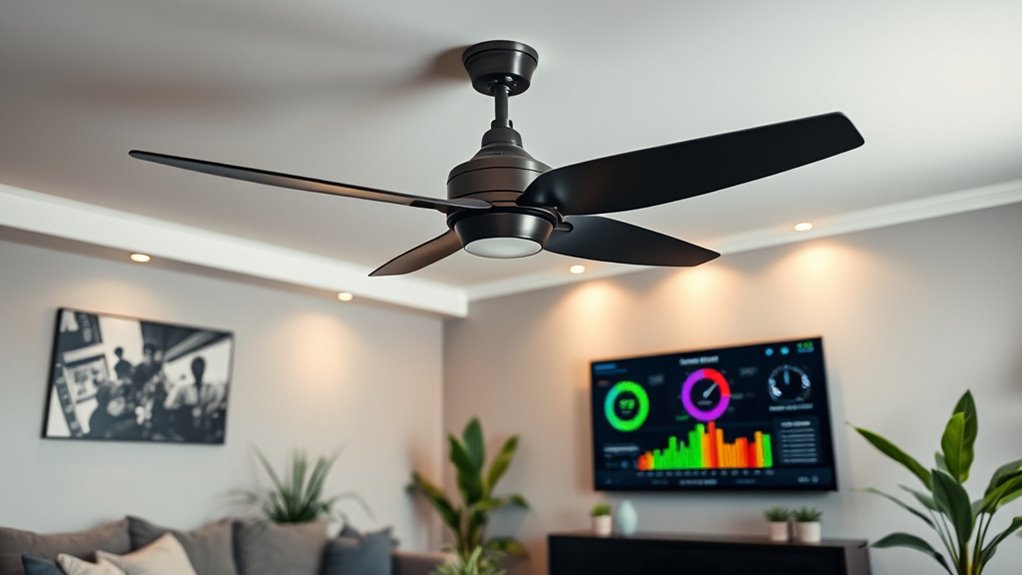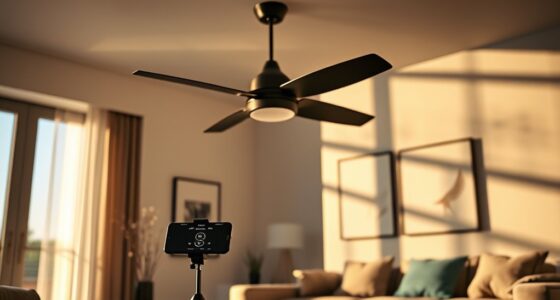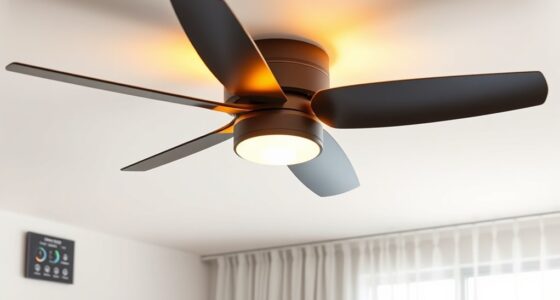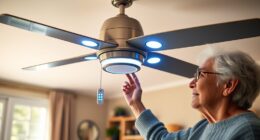Integrating fans with your home energy-monitoring system helps you save energy, cut costs, and boost comfort. By connecting fans, you gain real-time insights into their power use and performance, allowing you to automate operation based on temperature or occupancy. Many compatible fans support Wi-Fi or smart protocols, making setup straightforward. Monitoring and analyzing this data helps you optimize airflow and energy efficiency further. Keep exploring to discover how this integration can transform your home environment.
Key Takeaways
- Connect compatible fans via Wi-Fi, Zigbee, or Z-Wave to enable real-time monitoring and control within home energy systems.
- Use dedicated apps or control panels to configure fan settings, airflow, and energy consumption data for optimized operation.
- Automate fan operation based on temperature, occupancy, or energy usage patterns to enhance efficiency and comfort.
- Regularly analyze energy consumption data to identify high-use periods and adjust settings for savings and longevity.
- Leverage future smart home trends like machine learning and voice control for seamless, personalized fan energy management.
Benefits of Connecting Fans to Home Energy Systems

Connecting fans to your home energy-monitoring system offers immediate benefits in energy efficiency and cost savings. When you monitor fan efficiency, you can identify how much energy each fan consumes and adjust usage accordingly. This helps prevent overuse and reduces your electricity bills. Additionally, tracking acoustic performance allows you to select fans that operate quietly, enhancing your comfort without sacrificing functionality. Smart systems enable you to optimize fan operation for different rooms and times of day, ensuring they run only when needed. Properly maintained fans contribute to appliance longevity and overall home safety by preventing overheating and mechanical failures. Incorporating energy-saving practices further enhances these benefits by promoting mindful usage habits. Utilizing home automation technology can streamline control and scheduling, maximizing efficiency. As a result, you experience less waste, lower energy costs, and a more comfortable home environment. Overall, integrating fans with your energy system provides precise control, improved performance, and significant savings.
Types of Fans Compatible With Smart Monitoring

Smart monitoring systems are compatible with a variety of fan types, allowing you to customize your home’s ventilation and cooling solutions. When choosing smart fan types, consider compatibility considerations such as connectivity protocols (Wi-Fi, Zigbee, Z-Wave) and control options. Many smart ceiling fans easily integrate with home energy systems, offering features like remote control and automation. Portable fans with smart plugs can also be included, provided they support your system’s communication standards. Some fans may require specific hubs or controllers for seamless integration. Always verify that the fan’s specifications match your home energy-monitoring setup to ensure smooth operation. By understanding compatibility considerations, you can select the right smart fans that optimize energy use and enhance comfort. Additionally, selecting fans made from energy-efficient materials can further reduce your overall energy consumption. Incorporating system compatibility ensures that your smart home remains seamlessly connected and efficient.
How to Set Up Your Fan Integration
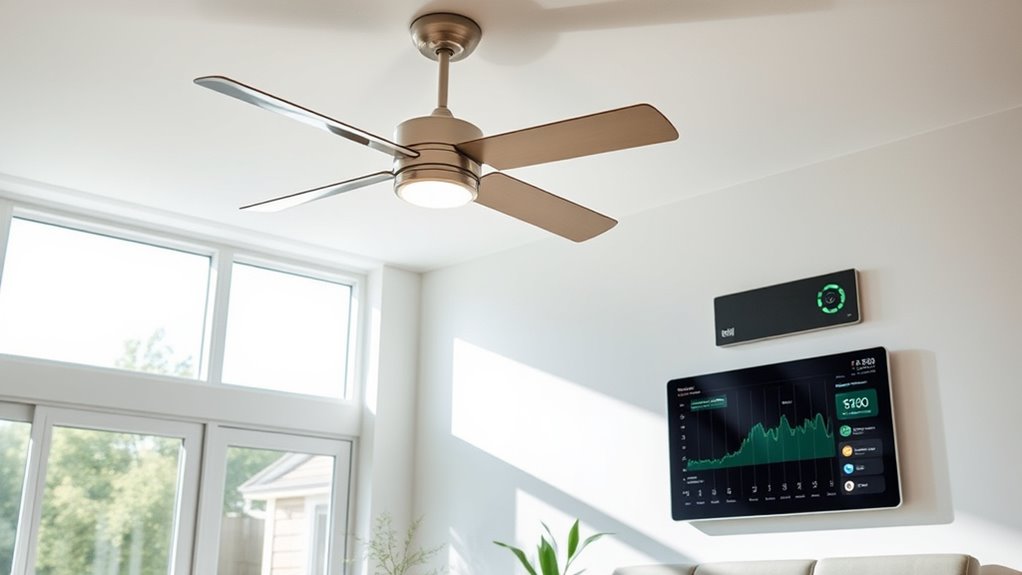
To set up your fan integration, start by connecting the fan to your home Wi-Fi network. Next, install and configure the monitoring software to track energy usage and control settings. Once these steps are complete, you’ll be ready to optimize your fan’s performance through your smart system. Be sure to familiarize yourself with energy-efficient appliances to maximize savings and performance. Incorporating smart home technology can further enhance your control and efficiency.
Connect Fan to Network
Setting up your fan to connect to your home network is a straightforward process that guarantees seamless control and monitoring. First, ensure your smart fan is placed in an ideal location with good smart fan placement, ideally near your Wi-Fi router for stronger signals. Many fans support Bluetooth connectivity, which simplifies initial pairing. Turn on your fan and activate Bluetooth on your smartphone or control device. Follow the manufacturer’s instructions to pair the fan via Bluetooth, ensuring it’s recognized by your device. Once paired, access the fan’s settings through the dedicated app or control panel. From there, connect the fan to your Wi-Fi network if prompted, completing the setup for remote control and integration with your home energy-monitoring system. Additionally, understanding sound vibrations can help optimize your system’s performance and health benefits. Ensuring your fan’s connectivity options are compatible with your existing home network is also crucial for a smooth setup process. Being aware of low light office plants can also assist in optimizing your home environment for electronic device placement, promoting better performance and longevity.
Configure Monitoring Software
Once your fan is connected to your home network, the next step is configuring your monitoring software to integrate it effectively. Start by accessing the software’s dashboard and locating the device setup section. You’ll need to input details about your fan motor, ensuring the software recognizes its specifications. Adjust airflow control settings to optimize performance and energy efficiency. Set parameters for real-time monitoring, such as airflow rate and power consumption, to track efficiency. Make sure to calibrate the system if necessary, aligning software readings with actual airflow and fan motor activity. Proper configuration ensures you can monitor and control your fan seamlessly, maximizing energy savings and maintaining comfortable airflow throughout your home. This setup helps you leverage your home energy system fully, especially considering the privacy and cookie policies that govern data collection and user control. Additionally, referring to industry best practices for voice over script optimization can improve how your monitoring alerts and notifications are delivered for clarity and responsiveness. Incorporating knowledge of business hours for local stores like Ulta Beauty or Sephora can also assist in scheduling maintenance or updates during appropriate times, ensuring minimal disruption.
Automating Fan Operation Based on Data Insights
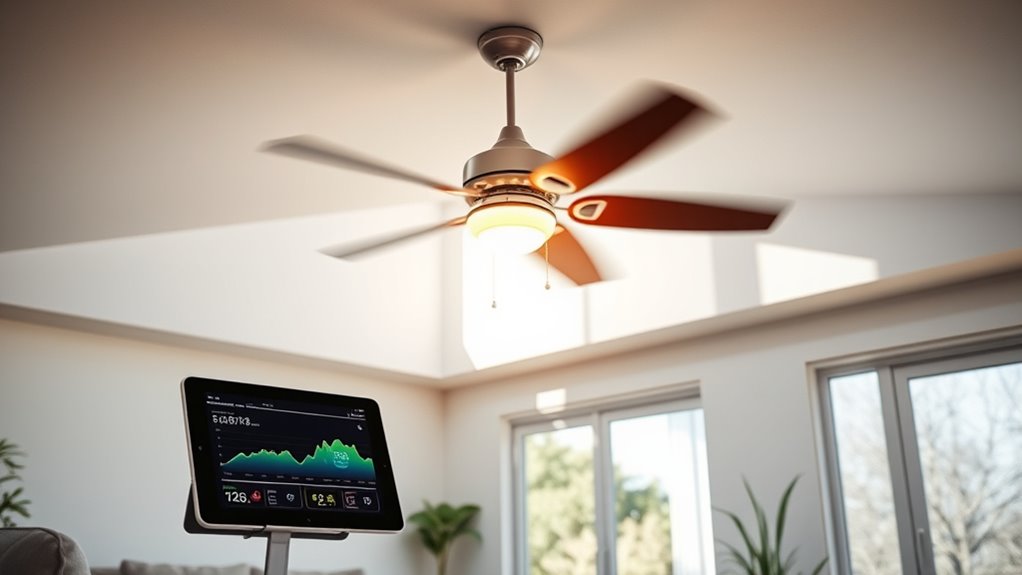
By using data insights, you can automate your fan to run only when needed, saving energy and reducing costs. Temperature-based control guarantees your fan activates at ideal times, maintaining comfort efficiently. Implementing these strategies helps you maximize energy savings without sacrificing performance. Additionally, integrating engine tuning techniques can enhance your system’s responsiveness and efficiency, ensuring optimal operation. Understanding home energy‑monitoring systems is essential for tailoring your setup to your specific needs and achieving the best results.
Temperature-Based Fan Control
When your home energy-monitoring system detects rising temperatures, it can automatically activate fans to cool the space without any manual intervention. This temperature-based fan control enhances ventilation efficiency by ensuring fans turn on only when needed, preventing unnecessary energy use. By responding dynamically to temperature data, the system optimizes airflow, helping to maintain a comfortable environment. This targeted approach reduces the need for constant manual adjustments, freeing you from micromanaging cooling efforts. As fans run only during temperature spikes, you also extend their lifespan and improve overall system longevity. Additionally, integrating proper tuning can ensure that fans operate at optimal speeds for energy efficiency and performance. Implementing smart control algorithms further refines this process, making your home even more responsive to changing conditions. For example, incorporating sensor calibration ensures that temperature readings are accurate, which is crucial for effective fan operation. Ultimately, temperature-based control creates a smarter, more responsive home, blending comfort with energy-conscious operation through precise airflow optimization.
Energy Savings Optimization
Utilizing data insights from your home energy-monitoring system allows you to automate fan operation for maximum energy savings. By analyzing patterns in ventilation efficiency, you can schedule fans to run only when needed, reducing unnecessary energy use. Automated controls prevent fans from operating continuously, which not only conserves power but also enhances fan durability by minimizing wear and tear. You can set your system to respond to real-time data, turning fans off during low-ventilation periods and activating them when airflow is insufficient. This targeted approach optimizes overall energy consumption while maintaining proper airflow. Implementing energy-efficient solutions can further amplify savings and system performance. As a result, your home stays comfortable, energy bills drop, and your fans last longer, delivering reliable performance over time.
Monitoring and Analyzing Energy Consumption

Monitoring and analyzing your energy consumption allows you to gain clear insights into how your home uses power. With this data, you can identify patterns and areas for improvement. Use your home energy-monitoring system’s user interface design to easily track fan usage and efficiency. Regularly check for fan maintenance needs to guarantee top performance. Here are key steps:
- Review real-time data on energy use to spot high-consumption periods.
- Analyze historical trends to understand seasonal or daily fluctuations.
- Use insights to adjust fan operation for maximum efficiency.
- Keep your system’s user interface simple and accessible for quick monitoring and decision-making.
Tips for Maximizing Energy Savings With Fans
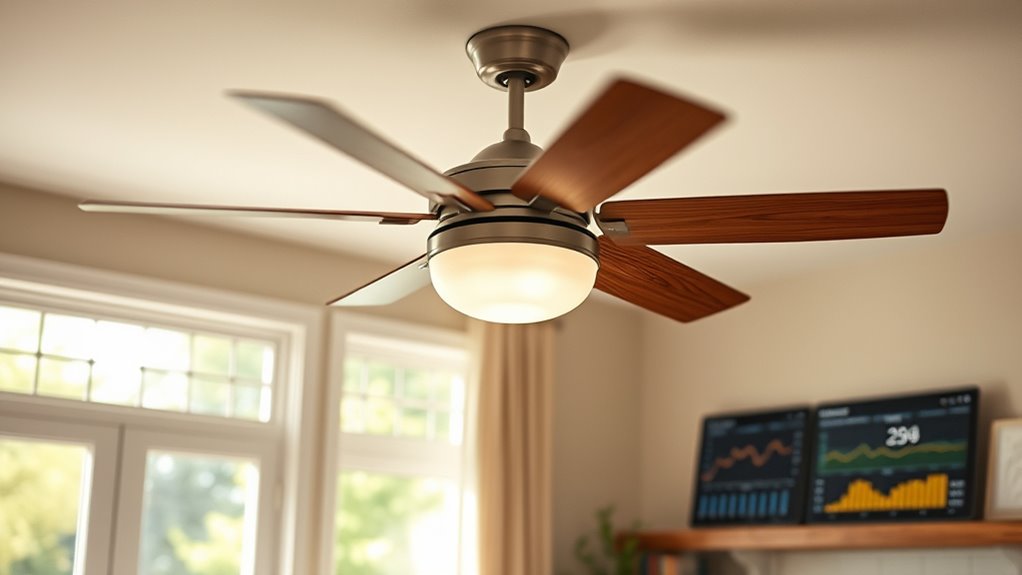
To maximize energy savings with your fans, start by setting them to operate only when needed. This prevents unnecessary energy use and improves airflow efficiency. Use timers or smart controls to automatically turn fans off when rooms are unoccupied. Regular fan maintenance is essential; clean blades and vents to guarantee optimal airflow and prevent strain on the motor. Well-maintained fans run more efficiently, reducing energy consumption. Adjust fan speeds to match current conditions—using higher speeds only when necessary. Also, consider ceiling fans with reversible motors to switch directions seasonally, enhancing airflow without extra energy. By combining strategic operation with routine maintenance, you can substantially boost your fans’ efficiency and save energy in the long run.
Future Trends in Smart Fan and Energy System Integration
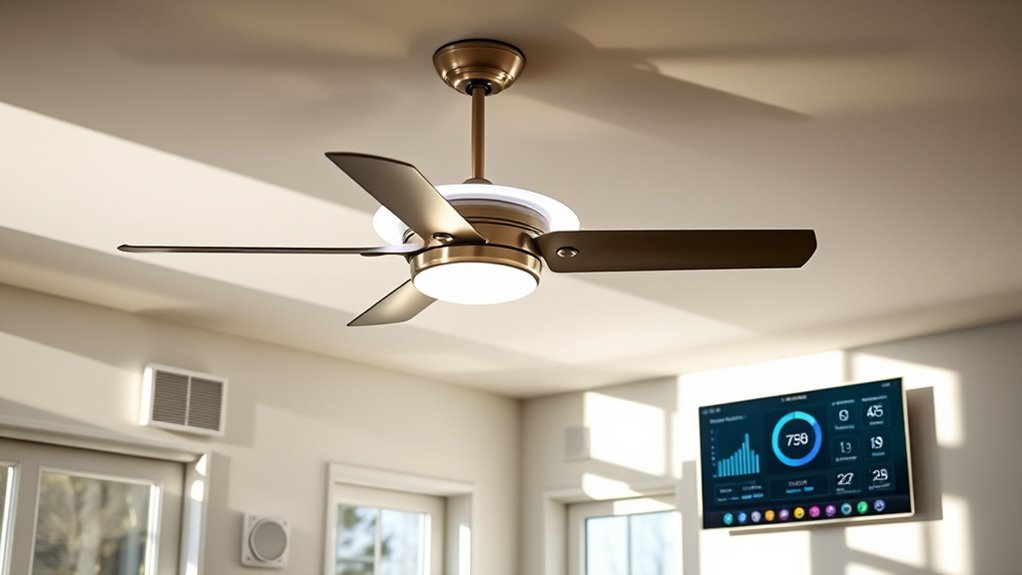
Advancements in smart home technology are paving the way for more integrated and efficient energy management systems, especially when it comes to fans. Future trends include enhanced wireless protocols that enable seamless communication between fans and home automation hubs. You’ll see smarter user interfaces that make controlling and customizing fan settings easier via apps or voice commands. Additionally, expect adaptive systems that learn your preferences and optimize energy use automatically. Here are some key developments:
- Adoption of low-latency wireless protocols like Zigbee and Z-Wave.
- Improved user interfaces with intuitive controls and real-time feedback.
- Integration of machine learning for predictive energy management.
- Greater compatibility across diverse smart home devices and platforms.
These trends will make managing fans more effortless, personalized, and energy-efficient.
Frequently Asked Questions
Can Existing Fans Be Retrofitted for Smart Home Integration?
Yes, you can retrofit existing fans for smart fan controls. Many fans are compatible with simple fan retrofit kits that add smart features, allowing you to control them via your smartphone or voice commands. These kits typically include a smart switch or module that integrates with your home’s system. Just make certain your fan supports retrofit options, and follow installation instructions for a seamless upgrade to smart home integration.
How Secure Is Data Sharing Between Fans and Energy Systems?
You might wonder how secure data sharing is between fans and energy systems. Generally, manufacturers use data encryption to protect your information, reducing risks of hacking or unauthorized access. However, privacy concerns still exist if sensitive data isn’t properly safeguarded or if systems lack regular updates. To stay safe, choose reputable brands that prioritize strong encryption and transparent privacy policies, ensuring your data remains secure during sharing.
What Is the Typical Cost of Integrating Fans With Home Energy Systems?
Back in the days of dial-up internet, integrating fans with home energy systems was rare, but now, it’s more common and affordable. You’ll find that the cost analysis typically ranges from $100 to $300, depending on the fan type and system compatibility. Installation procedures are straightforward, often DIY-friendly, but hiring a professional can guarantee ideal setup and integration, boosting your home’s efficiency and comfort without breaking the bank.
Are There Specific Brands or Models Recommended for Compatibility?
When choosing fans for your energy-monitoring system, focus on brand compatibility and model recommendations. Look for brands like Lutron, Honeywell, or Leviton, which are known for seamless integration with smart home systems. Check the model specifications to guarantee they support your existing setup. Reading reviews and consulting with experts can also help you identify the best options that will work smoothly with your home energy system.
How Does Fan Integration Impact Overall Home Energy Efficiency?
Did you know that integrating fans with home energy-monitoring systems can boost energy savings by up to 30%? When you connect fans to your system, you optimize airflow based on real-time data, reducing unnecessary energy use. This not only enhances user comfort but also lowers your energy bills. Overall, fan integration makes your home smarter and more efficient, giving you better control and long-term savings.
Conclusion
By integrating fans with your home energy system, you open smarter living—saving energy and money while enhancing comfort. Imagine your home as a symphony, each device working in harmony through data-driven insights. With the right setup, your fan becomes a silent, efficient partner in your energy journey. So, why not embrace this future? After all, isn’t a smarter home the key to a more sustainable and comfortable life?
